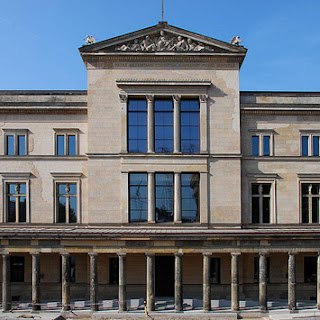From desert tomb to a bomb-scarred prison in Berlin - having ruled as queen of a revolutionary pharaoh some 3,400 years ago, sitting at his side in the new city he built in the middle of the Egyptian desert, Nefertiti now is imprisoned in the bomb-scarred museum restored in Berlin as her jail.
The restored jail was designed by the famous British architect, Sir David Allan Chipperfield.
The Neues Museum (New Museum) is the final act in the restoration of the Museum Island complex which was commissioned by Prussian kaisers.
The museum complex was bombed by the Royal Air Force in 1943, during the Second World War. Chipperfield retained some of the damage:
As part of the restoration concept, Chipperfield chose to leave many of the wartime scars inflicted on the building untouched. In the main entrance ... the walls remain stripped back to bare brick.
The bust of the lovely queen looks forlorn in her new jail, just as she looked lonely in the one she was imprisoned in while the New Museum was being restored.
 | |
| Nefertiti Bust in the New Museum in Berlin, Germany |
Nefertiti married pharaoh Amenhotep IV, who reigned around 1353 BC. Amenhotep was a religious revolutionary. By his time there had been a god-merger, with three gods - Ra, Amun and Horus - merged into one, so that they were all identified with each other. He
took this one stage further by trying to persuade people that the troika was one god, and that supreme god was Amen. He took the worship of Amen out of the dark inner sanctums of the temples, into the open, sunlit areas. He succeeded for a while, but only because he had the power.
took this one stage further by trying to persuade people that the troika was one god, and that supreme god was Amen. He took the worship of Amen out of the dark inner sanctums of the temples, into the open, sunlit areas. He succeeded for a while, but only because he had the power.
After his death things reverted to the old ways again, and it was payback time - much of the art and many of the buildings of his time were defaced. Later pharaohs took blocks of stone from his monuments and temples to build other tombs.
King Tut, his successor, beat a hasty retreat from his father's city of Akhetaten, perhaps because of a flu outbreak, and the new religion died. too.
Even good old Sigmund Freud got in on the act. He claimed in his book Moses and Monotheism that this pharaoh's drive to have only one god was later picked up by Judaism.
 | |
| Nefertiti's husband - Amenhotep IV |
It's a bit ironic that the revolutionary pharaoh is known today as a failure, while his lovely wife, Nefertiti, lives on in people's imagination because the beauty of her face was captured in a painted bust.
They were pretty fond of each other. You can see it in photos of some drawings of the time, showing them holding hands, and Nefertiti kissing her daughter.
It was the one and only time in when such natural poses were shown of a pharaoh and his wife. A very natural style of art developed in his court, but it ended when he died.
They had a spat and parted company, with Nerfertiti, who had six daughters but no son, going to live in the northern palace with her daughter and her husband, the future King Tut.
Tut turned his back on his father-in-law's new religion, and switched back to the old gods, before he died at eighteen.
His father's push for one single god really rattled the establishment. Later generations of pharaohs took her husband's name, and son Tut's name, off the list of kings, and Amenhotep was unknown as a king for more than three thousand years. In the nineteenth century some archeologists dug up traces, and his history was revealed once again. | |
| Nefertiti, Amenhotep IV and their children |
 | ||
| Nefertiti being installed in the New Museum in Berlin |
 |
| Nefertiti bust being admired by Prince Charles & Lady Camilla |
 | |
| New Museum in Berlin exterior - new jail of Nefertiti bust |

Great piece, awesome way of writing. Well done.
ReplyDeleteThere is a reason for Nefertiti's enshrinement in Germany's (and Europe's really, but don't mention this to the French and English) capital. Nefertiti was much much more than just Akhenaton's chief wife. If anything it was Akhenaton playing second fiddle. Nefertiti = Light, pure unadulterated. Well protected from anyone inside the heart of Europe to guide our future as humanity.
Hi great reading your blog
ReplyDelete